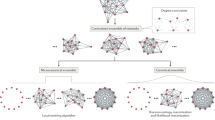Abstract
We propose methodology for exact statistical tests of hypotheses for models of network dynamics. The methodology formulates Markovian exponential families, then uses sequential importance sampling to compute expectations within basins of attraction and within level sets of a sufficient statistic for an over-dispersion model. Comparisons of hypotheses can be done conditional on basins of attraction. Examples are presented.
Similar content being viewed by others
References
Albert, R., Othmer, H.G. (2003). The topology of the regulatory interactions predicts the expression pattern of the segment polarity genes in Drosophila melanogaster. Journal of Theoretical Biology, 223, 1–18.
Aoki, S., Hara, H., Takemura, A. (2012). Markov Bases in Algebraic Statistics. New York: Springer.
Bender, C., Henjes, F., Fröhlich, H., Weimann, S., Korf, U., Beissbarth, T. (2010). Dynamic deterministic effects propagation networks: learning signalling pathways from longitudinal protein array data. Bioinformatics, 26, 596–602.
Bender, C., Heyde, S., Henjes, F., Wiemann, S., Korf, U., Beissbarth, T. (2011). Inferring signalling networks from longitudinal data using sampling based approaches in the R-package ’ddepn’. BMC Bioinformatics, 12, 291.
Bickel, P.J., Doksum, K.A. (2007). Mathematical Statistics (2nd ed., Vol. I). Upper Saddle River: Pearson.
Casella, G., Berger, R.L. (2002). Statistical Inference (2nd ed.). Pacific Grove: Duxbury.
Chen, Y., Diaconis, P., Holmes, S.P., Liu, J.S. (2005). Sequential Monte Carlo methods for statistical analysis of tables. Journal of the American Statistical Association, 100, 109–120.
Chen, Y., Dinwoodie, I.H., Sullivant, S. (2006). Sequential importance sampling for multiway tables. Annals of Statistics, 34, 523–545.
Cox, D., Little, J., O’Shea, D. (1998). Using Algebraic Geometry. New York: Springer.
Decker, W., Greuel, G.-M., Pfister, G., Schönemann, H. (2011). Singular 3-1-3: a computer algebra system for polynomial computations. http://www.singular.uni-kl.de.
Diaconis, P., Efron, B. (1985). Testing for Independence in a two-way table: new interpretations of the Chi-square statistic. Annals of Statistics, 13, 845–874.
Dinwoodie, I.H. (2011). Sequential importance sampling of binary sequences. Statistics and Computing, 22, 53–63.
Dinwoodie, I.H. (2012). Conditional tests on basins of attraction with finite fields. Methodology and Computing in Applied Probability, to appear.
Drton, M., Sturmfels, B., Sullivant, S. (2008). Lectures on Algebraic Statistics. Boston: Birkhäuser.
Frank, A. and Asuncion, A. (2010). UCI machine learning repository. Irvine: University of California, School of Information and Computer Science. http://archive.ics.uci.edu/ml.
Grayson, D.R., Stillman, M.E. (2012). Macaulay2, a software system for research in algebraic geometry. Available at http://www.math.uiuc.edu/Macaulay2/.
Guo, S.W., Thompson, E.A. (1992). Performing the exact test of Hardy–Weinberg proportion for multiple alleles. Biometrics, 48, 361–372.
Klamt, S., Saez-Rodriquez, J., Lindquist, J.A., Simeoni, L., Gilles, E.D. (2006). A methodology for the structural and functional analysis of signalling and regulatory networks. BMC Bioinformatics, 7, 1471–2105.
Kreuzer, M., Robbiano, L. (2000). Computational Commutative Algebra I. New York: Springer.
Li, S., Assmann, S.M., Albert, R. (2006). Predicting essential components of signal transduction networks: a dynamic model of guard cell abscisic acid signaling. PLoS Biology, 4, 1733–1748.
Liu, J.S. (2001). Monte Carlo Strategies in Scientific Computing. New York: Springer.
Mendoza, L. (2006). A network model for the control of the differentiation process in Th cells. Biosystems, 84, 101–114.
Morris, M.K., Saez-Rodriguez, J., Sorger, P.K., Lauffenburger, D.A. (2010). Logic-based models for the analysis of cell signaling networks. Biochemistry, 49, 3216–3224.
Müssel, C., Hopfensitz, M., Kestler, H.A. (2010). BoolNet: an R package for generation, reconstruction and analysis of Boolean networks. Bioinformatics, 26, 1378–1380.
Ramanan, V.K., Kim, S., Holohan, K., Shen, L., Nho, K., Risacher, S.L., et al. (2012). Genome-wide pathway analysis of memory impairment in the Alzheimer’s Disease Neuroimaging Initiative (ADNI) cohort implicates gene candidates, canonical pathways, and networks. Brain Imaging and Behaviour, 6, 634–648.
Riccomagno, E., Pistone, G., Wynn, H.P. (2000). Algebraic Statistics. London: Chapman and Hall.
Saadatpour, A., Albert, I., Albert, R. (2010). Attractor analysis of asynchronous Boolean models of signal transduction networks. Journal of Theoretical Biology, 266, 641–656.
Saez-Rodriguez, J., Simeoni, L., Lindquist, J. A., Hemenway, R., Bommhardt, U., Arndt, B., et al. (2007). A logical model provides insights into T cell receptor signalling. PLOS Computational Biology, 3, 1580–1590.
Saez-Rodriquez, J., Alexopoulos, L.G., Zhang, M., Morris, M., Lauffenburger, D.A., Sorger, P.K. (2011). Comparing Signaling Networks between normal and transformed hepatocytes using discrete logical models. Cancer Research, 71, 5400–5411.
Scutari, M. (2010). Learning Bayesian networks with the bnlearn R Package. Journal of Statistical Software, 35, 1–22. http://www.jstatsoft.org/v35/i03/.
Stigler, B. (2006). Polynomial dynamical systems in systems biology. AMS 2006. Proceedings of Symposia in Applied Mathematics, 64, 59–84.
Thomas, R. (1973). Boolean formalization of genetic control circuits. Journal of Theoretical Biology, 42, 563–585.
Thomas, R. (1998). Laws for the dynamics of regulatory networks. International Journal of Developmental Biology, 42, 479–485.
Author information
Authors and Affiliations
Corresponding author
About this article
Cite this article
Dinwoodie, I.H., Pandya, K. Exact tests for singular network data . Ann Inst Stat Math 67, 687–706 (2015). https://doi.org/10.1007/s10463-014-0472-y
Received:
Revised:
Published:
Issue Date:
DOI: https://doi.org/10.1007/s10463-014-0472-y



